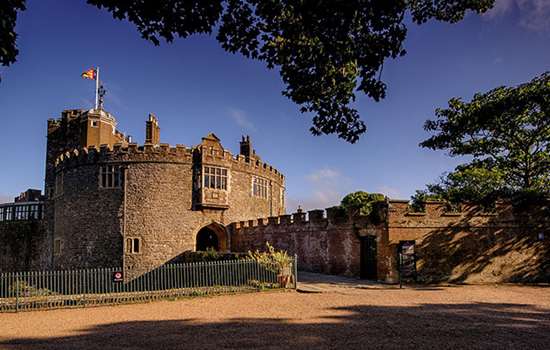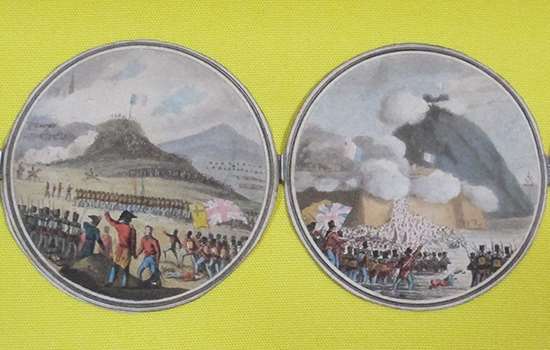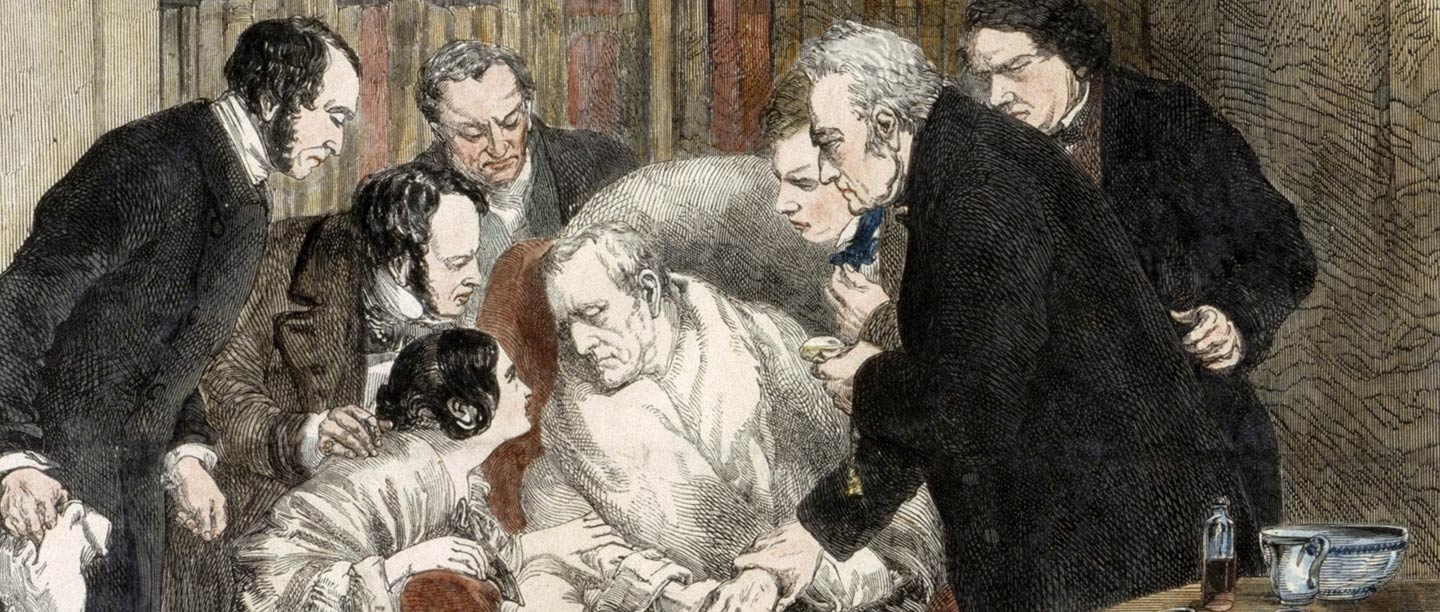1. The Duke of Wellington Lying in State at Chelsea hospital, 1852
While the funeral was arranged, thousands of mourners, including the Queen, paid their respects to the Duke at Chelsea. The clamour was so great that three people died in the crush.
2. Letter describing the funeral, from George Campbell, 8th Duke of Argyll, to Lord John Russell, 19 November 1852
The group of old warriors standing round the descending Body – and at last on the edge of the aperture into which it fell – was the most beautiful and touching sight which imagination can conceive.
3. Relics from Wellington’s funeral, 1852
Velvet upholstery from the Duke’s coffin and a piece of the pall, removed after the funeral by the Duke’s butler, Christopher Collins.
4. The funeral cortege approaching St. Paul’s Cathedral, 1852
The funeral carriage, made from cannon captured at Waterloo, weighed over 18 tons and was drawn by 12 dray horses.
5. Medal commemorating the funeral of the Duke, 1852
Image of St Paul’s Cathedral, where the funeral was held and the Duke laid to rest in the crypt beneath the great dome, on 18 November 1852.
6. Printing plate for the funeral invitations, 1852
7. Ticket to the Duke’s funeral, 1852
Fifteen thousand people assembled in St Paul’s Cathedral, London, for the funeral.
8. The last moments of the Duke of Wellington, 1852
A hand-coloured engraving from the Illustrated London News, imagining the scene at Walmer as the Duke was dying, and showing who was present.
9. Locket of the Duke’s hair, 1852
Cutting of the Duke of Wellington’s hair, taken on the day of his death, 14 September 1852.
10. Letter to the surgeon who attended the Duke’s death, 15 September 1852
Written by Earl De La Warr, he asks Mr Hulke to tell him ‘a few particulars of the last moment’ of the Duke and perceptively comments: ‘Now it will be seen how a nation can mourn.’
11. Bronze death mask of the Duke of Wellington, 1853
From a plaster cast made by the sculptor George Gammon Adams, three days after the Duke’s death. Originally limited to royalty, the taking of death masks of the famous and infamous was popular in the 19th century.
12. Wellington’s monogrammed silk handkerchief, 1852
Given to Walmer by Kendal, Wellington’s valet, who described how it was tied around the top of the Duke’s head and jaws, shortly after death, to keep his face in repose.
13. Bronze bust of Wellington, 1852
By Baron Carlo Marochetti an Italian sculptor, whose foundry produced numerous major works, including the lions around Nelson’s column.
14. Parian ware bust of the Duke, 1852
Wellington sat for Henry Weigall on 18 November 1851, the last sitting the Duke gave for any artist. His bust was first advertised, after the Duke’s death, in the Illustrated London News’s commemorative edition, 23 October 1852.
15. Staffordshire figure of the Duke seated on chair, 1852
A figure sold before the Duke’s death, this version has had its head tilted whilst the clay was soft, and was then sold as a commemorative figure.
16. Opaque glass bust of the Duke of Wellington, 1852
A rare glass copy of Marochetti’s bust, sold by Osler, the foremost chandelier makers, from their Oxford Street branch.
17. Electroplated silver mourning brooch, 1852
Made by Elkingtons, Birmingham silversmiths who popularised the electroplating process, enabling the mass production of high quality silver plate for middle class dining tables.
18. Silver medal commemorating the death of Wellington, 1852
19. Whisky jug celebrating the centenary of Waterloo, 1915
Jug with portraits of Wellington and Kitchener, Secretary of State for War (1914–16). Made for James Watson, Scottish distillers, a trial version that was not widely distributed.
20. Five pound note featuring Wellington’s portrait
Based on Sir Thomas Lawrence’s portrait of the Duke, it was in circulation from November 1971 to November 1991.
21. German tin flat toy soldier of the Duke on Copenhagen, c.1910
As a child in the 1880s, Winston Churchill played with a set of tin flat soldiers of the Battle of Waterloo. At this time only the rich could afford toy soldiers, but by 1910 their price had fallen and the weekly production of the north London firm, Britains Ltd, was over 200,000.
22. A new game of Wellington’s Victories, c.1850s
Wellington was idolized in children’s books and games as the model military hero throughout the 19th century.
23. Battle of Waterloo, a theatrical sheet for Pollock’s toy theatres, late 19th century
J Amhurst’s original play was staged in 1824 in Astley’s theatre ‘in the round.’ A melodrama with music, real horses, cannons and ‘some of the very cavalrymen who had helped win the War against Boney.’
Find out more
-

History of Walmer Castle
Read the full history of Walmer Castle, from its days as a Tudor fort, defending the coast from invasion, to its transformation into the elegant residence we see today.
-

Life of the Duke collection
Explore the life of the Duke of Wellington through this collection, which includes the duke’s boots and his uniform jacket as Lord Warden of the Cinque Ports.

